interpolator(插值器)详解二
来源:互联网 发布:西西软件下载手机软件 编辑:程序博客网 时间:2024/06/05 03:52
6.AnticipateInterpolator 回荡秋千插值器
这个插值器的值变化过程,可以想像成荡秋千时的一个段过程。(此时秋千已经在比较上面的位置了,一放手就可以荡下来)。你开始用力推向更上面,然后秋千终将荡回下面。
tension值就好比推力的大小。
源代码如下:
01package android.view.animation;02 03import android.content.Context;04import android.content.res.TypedArray;05import android.util.AttributeSet;06 07/**08 * 一个开始向后荡,然后向前荡的插值器。09 * <hr/>10 * An interpolator where the change starts backward then flings forward.11 */12public class AnticipateInterpolator implements Interpolator {13 private final float mTension;14 15 public AnticipateInterpolator() {16 mTension = 2.0f;17 }18 19 /**20 * @param tension21 * 绷紧程度,当绷紧程序为0.0f时,也就没有了反向作用力。插值器将退化成一个y=x^3的加速插值器。22 * <br/>23 * Amount of anticipation. When tension equals 0.0f, there is24 * no anticipation and the interpolator becomes a simple25 * acceleration interpolator.26 */27 public AnticipateInterpolator(float tension) {28 mTension = tension;29 }30 31 public AnticipateInterpolator(Context context, AttributeSet attrs) {32 TypedArray a = context.obtainStyledAttributes(attrs,33 com.android.internal.R.styleable.AnticipateInterpolator);34 35 mTension =36 a.getFloat(com.android.internal.R.styleable.AnticipateInterpolator_tension, 2.0f);37 38 a.recycle();39 }40 41 @Override42 public float getInterpolation(float t) {43 // a(t) = t * t * ((tension + 1) * t - tension)44 return t * t * (((mTension + 1) * t) - mTension);45 }46}根据getInterpolation()方法。
当tension为默认值2.0f时,曲线图如下:
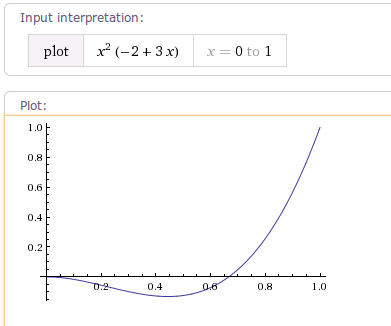
当tension值为4.0f时,曲线图如下:
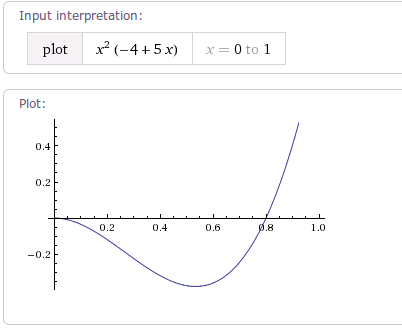
7. AnticipateOvershootInterpolator
源代码如下:
01package android.view.animation;02 03import android.content.Context;04import android.content.res.TypedArray;05import android.util.AttributeSet;06 07/**08 * 一个插值器它开始向上推,然后向下荡,荡过最低线。然后再回到最低线。09 * <hr/>10 * An interpolator where the change starts backward then flings forward and overshoots11 * the target value and finally goes back to the final value.12 */13public class AnticipateOvershootInterpolator implements Interpolator {14 private final float mTension;15 16 public AnticipateOvershootInterpolator() {17 mTension = 2.0f * 1.5f;18 }19 20 /**21 * @param tension22 * anticipation/overshoot的比值。当和tension值为0.0f时,23 * 也就没有anticipation/overshoot的比值了,插值器退化为一个加速/减速插值器。24 * <br/>25 * Amount of anticipation/overshoot. When tension equals 0.0f,26 * there is no anticipation/overshoot and the interpolator becomes27 * a simple acceleration/deceleration interpolator.28 */29 public AnticipateOvershootInterpolator(float tension) {30 mTension = tension * 1.5f;31 }32 33 /**34 * @param tension Amount of anticipation/overshoot. When tension equals 0.0f,35 * there is no anticipation/overshoot and the interpolator becomes36 * a simple acceleration/deceleration interpolator.37 * @param extraTension38 * 乘以tension的值。例如,在上面构造函数中extraTension的值为1.5f39 * <br/>40 * Amount by which to multiply the tension. For instance,41 * to get the same overshoot as an OvershootInterpolator with42 * a tension of 2.0f, you would use an extraTension of 1.5f.43 */44 public AnticipateOvershootInterpolator(float tension, float extraTension) {45 mTension = tension * extraTension;46 }47 48 public AnticipateOvershootInterpolator(Context context, AttributeSet attrs) {49 TypedArray a = context.obtainStyledAttributes(attrs, AnticipateOvershootInterpolator);50 51 mTension = a.getFloat(AnticipateOvershootInterpolator_tension, 2.0f) *52 a.getFloat(AnticipateOvershootInterpolator_extraTension, 1.5f);53 54 a.recycle();55 }56 57 private static float a(float t, float s) {58 return t * t * (((s + 1) * t) - s);59 }60 61 private static float o(float t, float s) {62 return t * t * (((s + 1) * t) + s);63 }64 65 @Override66 public float getInterpolation(float t) {67 // a(t, s) = t * t * ((s + 1) * t - s)68 // o(t, s) = t * t * ((s + 1) * t + s)69 // f(t) = 0.5 * a(t * 2, tension * extraTension), when t < 0.570 // f(t) = 0.5 * (o(t * 2 - 2, tension * extraTension) + 2), when t <= 1.071 if (t < 0.5f) return 0.5f * a(t * 2.0f, mTension);72 else return 0.5f * (o((t * 2.0f) - 2.0f, mTension) + 2.0f);73 }74}可以得到当tension为默认值时,曲线图为:
plot Piecewise[{{0.5((2x)*(2x)*((2+1)*2x-2)), 0<x<0.5}, {0.5*(((2x-2)*(2x-2)*((2+1)*(2x-2)+2))+2),0.5<=x<=1}}]
(不知道我的plot函数写对了没?)

8. CycleInterpolator 正弦周期变化插值器
源代码:
01package android.view.animation;02 03import android.content.Context;04import android.content.res.TypedArray;05import android.util.AttributeSet;06 07/**08 *09 * 以指定的周期重复动画。变化率曲线为正弦。10 * <hr/>11 * Repeats the animation for a specified number of cycles(周期). The12 * rate of change follows a sinusoidal(正弦) pattern.13 *14 */15public class CycleInterpolator implements Interpolator {16 /**17 *18 * @param cycles 要重复的周期数19 */20 public CycleInterpolator(float cycles) {21 mCycles = cycles;22 }23 24 public CycleInterpolator(Context context, AttributeSet attrs) {25 TypedArray a =26 context.obtainStyledAttributes(attrs, com.android.internal.R.styleable.CycleInterpolator);27 28 mCycles = a.getFloat(com.android.internal.R.styleable.CycleInterpolator_cycles, 1.0f);29 30 a.recycle();31 }32 33 @Override34 public float getInterpolation(float input) {35 return (float)(Math.sin(2 * mCycles * Math.PI * input));36 }37 38 private float mCycles;39}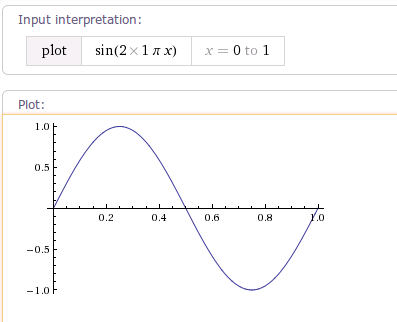
9. OvershootInterpolator
源代码:
01package android.view.animation;02 03import android.content.Context;04import android.content.res.TypedArray;05import android.util.AttributeSet;06 07/**08 * An interpolator where the change flings forward and overshoots the last value09 * then comes back.10 */11public class OvershootInterpolator implements Interpolator {12 private final float mTension;13 14 public OvershootInterpolator() {15 mTension = 2.0f;16 }17 18 /**19 * @param tension Amount of overshoot. When tension equals 0.0f, there is20 * no overshoot and the interpolator becomes a simple21 * deceleration interpolator.22 */23 public OvershootInterpolator(float tension) {24 mTension = tension;25 }26 27 public OvershootInterpolator(Context context, AttributeSet attrs) {28 TypedArray a = context.obtainStyledAttributes(attrs,29 com.android.internal.R.styleable.OvershootInterpolator);30 31 mTension =32 a.getFloat(com.android.internal.R.styleable.OvershootInterpolator_tension, 2.0f);33 34 a.recycle();35 }36 37 @Override38 public float getInterpolation(float t) {39 // _o(t) = t * t * ((tension + 1) * t + tension)40 // o(t) = _o(t - 1) + 141 t -= 1.0f;42 return (t * t * (((mTension + 1) * t) + mTension)) + 1.0f;43 //plot {(x-1)(x-1)((tension+1)(x-1)+tension)+1,(0<x<=1)}44 }45}当tension为默认值2时,曲线图如下:
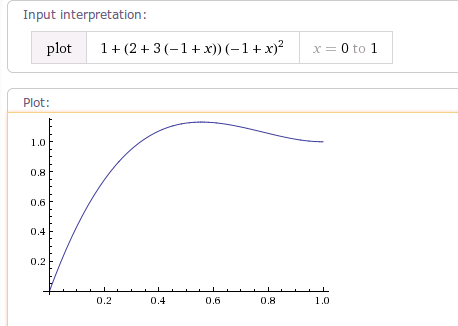
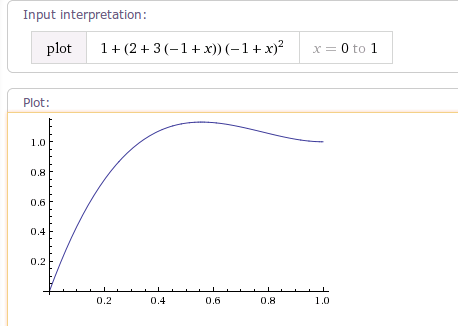
当tension的值为4时,曲线图如下:
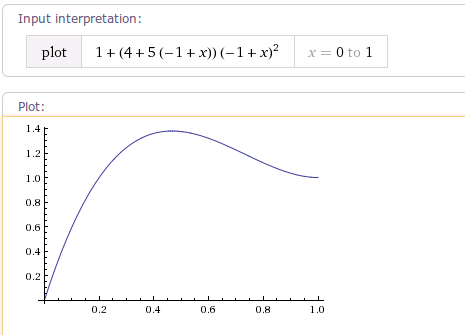

通过学习了解Android自带的这些Interpolator,我们可以很好的根据自己的使用场景使用这些Interpolator了。也可以很容易的写出我们自己的Interpolator。
0 0
- interpolator(插值器)详解二
- interpolator(插值器)详解一
- Interpolator插值器详解
- Animation动画详解(二)——Interpolator插值器
- Animation动画详解(二)——Interpolator插值器
- interpolator (插值器)的用法详解
- 插值器Interpolator配图详解
- 插值器Interpolator
- 插补器Interpolator详解
- android Interpolator详解
- [读书笔记]Android中Animation的Interpolator插值器详解(图文)
- 插补器Interpolator配图详解
- AGG 插值器(Interpolator)
- Android 动画 Interpolator插值器
- android interpolator 插值器
- android Interpolator动画插值器
- Android中的Interpolator(插值器)
- Android 插值器 Interpolator 介绍
- 《C++沉思录》-读书随记
- 【Swift】 Target-Action 模式
- ora-12514:TNS-listener ..错误 使用Oracle时报错
- 号:取ria4记录中某个号的内容 20140620
- Debug 不能设断点 或者断点错位 解决方法
- interpolator(插值器)详解二
- soap12 soap11的区别
- Linux下LCD 10分钟黑屏解决
- 找你妹+ipad+wifi,回忆那年的经典游戏
- int与Integer的区别
- HDU 1702简单的栈和队列
- Java编写 函数数组(键盘输入n个数) 冒泡排序
- 你是有那么爱他吗
- 经纬财富:渭南炒现货白银的七条做单习惯


